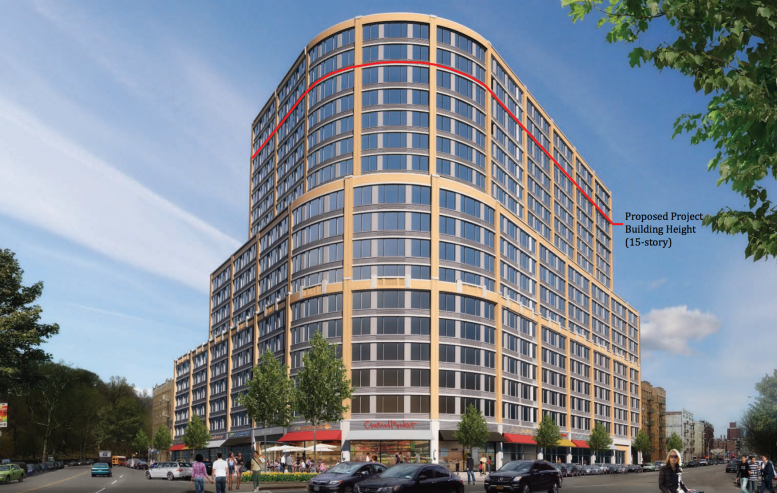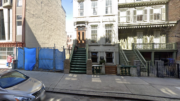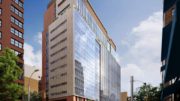After two weeks of haphazard fits and starts and a confrontational protest with tenant activists, City Council Member Ydanis Rodriguez and the City Council Land Use Committee unanimously disapproved a plan to rezone the corner of Broadway and Sherman avenues, which would have paved the way for the construction of a 15-story apartment building known as Sherman Plaza.
Washington Square Partners and Acadia Realty Trust had planned to build a 355-unit residential project at 4650 Broadway, in the borderlands between Inwood and Washington Heights. The city had worked out a deal with the developer to subsidize half those apartments—178 units—and rent them at below-market rates.
Initial plans had called for a tower as tall as 23 stories, but after negotiations with Manhattan Borough President Gale Brewer, the developers agreed to scale down the building to 15 stories, according to Politico New York. Without the rezoning, the developers could put up a 14-story, market-rate building with 199 apartments, according to zoning documents posted in June.
Rodriguez announced that he wouldn’t support the rezoning at a press conference last night in front of the development site on Broadway. The move came as an about-face for the councilman, who has said at a previous rally that it would bring much-needed affordable housing to the neighborhood.
In last night’s speech, which he also posted on Facebook, he said, “The building must be 50 percent affordable, it must provide ample permanent space for local cultural non-profits and neighborhood service providers, and it must be supportive to small businesses struggling to compete against big box stores, banks and chain pharmacies.”
It’s not entirely clear why Rodriguez changed his mind and pulled his support for project. It may have simply been pressure from his constituents. Roughly 100 Inwood residents gathered last week to oppose the development and argued that many long-term residents don’t earn enough to qualify for affordable units in the building, according to Gothamist. Housing activists claim the typical family living east of Broadway earns only $25,000, and the developers had hammered out a deal to rent 20 percent of the building’s units to families who earn an average of $31,000 a year (40 percent of the Area Median Income).
Sources told Politico that the councilman “began asking for perks the mayor’s team found too costly.”
“We didn’t think it was possible [to support the project] without major concessions to the community,” explained Russell Murphy, Rodriguez’s chief of staff. Those concessions included deeper affordability, large community spaces, and commercial spaces that offered reduced rents to small businesses.
Murphy explained that the council member had been focused on a planned rezoning of the neighborhood’s industrial zone. They hope to rezone Inwood’s eastern waterfront—which only allows manufacturing and commercial uses right now—to enable the construction of large, mixed-use buildings with affordable apartments. The New York City Economic Development Corporation (NYCEDC) released a plan for the northern tip of Manhattan last month, and the Department of City Planning should release initial zoning documents next month.
The Sherman Avenue tower would have been the first major project to secure city approval under Mayor Bill de Blasio’s new Mandatory Inclusionary Housing program. The policy, which was greenlighted by the City Council in March, requires any developer who wants to build on rezoned land to rent at least 20 percent of the units in their new building at below-market rates.
The large corner site on Broadway was formerly home to a Packard showroom, and is now a two-story garage with a curved facade.
Subscribe to the YIMBY newsletter for weekly updates on New York’s top projects
Subscribe to YIMBY’s daily e-mail
Follow YIMBYgram for real-time photo updates
Like YIMBY on Facebook
Follow YIMBY’s Twitter for the latest in YIMBYnews






Wow. As a northern Manhattan resident and follower of this project I’m dismayed at at the numerous inaccuracies in this report. Where are your fact checkers?
i’m not sure what you mean, but feel free to email me [email protected].
To clarify:
This was a rezoning application by a private developer to rezone (upzone) their property and only their property. It was not a “plan” by any means; it may well have qualified as a “spot zoning” and been challenged in court.
That application was initially for a huge zoning leap from R7 to R9, which under MIH/ZQA would have resulted in a 27 story building, not 23. After opposition, the zoning was slightly reduced to a combination of R9A and R8X that would have still more than doubled the residential FAR on the site from 3.44 to 7.81 and enabled a building up to 17 stories tall (175′). It would have required a “contextual” 12 story streetwall on Broadway next to 5 and 6 story buildings, which of course is not contextual at all.
According to the EAS you linked to, the rezoning would have enabled up to 413 units. Discussing the “planned” building as being smaller is irrelevant to evaluating the rezoning, since it would not have been binding with the land. The developer could have said they were planning to build 10 stories, or 3, or 1 – all that matters is the maximum the new zoning would allow any property owner to build to, and those maximums were problematic.
Furthermore, the statement you cribbed from Politico about 178 (or 50%) affordable units is erroneous. If you understand MIH, you would understand that there are only four possible options, all between 20% and 30%. Two options were mapped here — 20% of units at 40%AMI ($32k for family of three) or 30% of units at 80%AMI ($65k for family of three). The developer would pick at the time of building permit; politicians could not force one or the other. The developer could sell the site after the rezoning, thereby invalidating any CBAs or promises, and the new owner could pick 17 stories, 413 units, and 30% at 80%AMI, meaning not one affordable apartment for those making less than $65k in a family of three. This is what the community realized and eventually Rodriguez did too. Any promise of 50% affordability would rely on extra subsidies or financing programs with HPD that could not be guaranteed and would not be affordable (and in the case of HPD were suggested by the developer to be 10% at 60%AMI and 20% at 130%AMI).
And so bottom line, while the existing zoning might allow 199 market rate units, the aggressive rezoning would allow up to 330 market rate units, even after MIH. And while the existing zoning was not perfect, it did not create the urban planning issues that a monstrously bigger building would nor did it set a precedent for rezoning other soft sites in Inwood. (Did you know a rezoning similar to 4650 has already been filed to upzone a 6,000 SF property on Seaman Ave to R8A?)
And so now the existing zoning will remain, just as it does throughout Inwood, where it has worked fine in creating and maintaining a model medium-density, mid-rise neighborhood. That context may now extend east in the InwoodNYC plan, though there again there will be questions about R9 and R8 variants in an area that works very well (and supports a large population) under what is effectively R7A. The Packard showroom remains on the site at 4650 for now, and and it may well be redeveloped. That’s just fine, though one hopes the facade might be restored in any adaptive reuse. Redevelopment might even include one of those voluntary affordable programs, as the Stack did up the street a couple years ago. But privately-led spot rezonings to massively upzone properties under the political cover of MIH have been dealt a setback, which is as it should be.
Large is important business than little, with profit and run the market-rates grow up. (I think)
Although Inwood Resident says that the 50% figure is erroneous, Rodriguez is quoted as saying, “The building must be 50 percent affordable, it must provide ample permanent space for local cultural non-profits and neighborhood service providers, and it must be supportive to small businesses struggling to compete against big box stores, banks and chain pharmacies.”
In any event, Inwood Resident keeps harping on the idea that this building would be “monstrously bigger” and “massive,” and perhaps Inwood Resident would like to “maintaining a model medium-density, mid-rise neighborhood” in Inwood. However, by the standards of other Manhattan neighborhoods, a building with 330 units would not be extraordinary.
New York City has a housing crisis. Far more units need to be constructed in order to house everyone who wants to live in this city, and every neighborhood needs to share the burden of higher density, including Inwood.
In the end, Inwood residents demanded something unreasonable, and now a building only moderately smaller, which includes zero affordable units, will be constructed as of right. In other words, but making unreasonable demands, community activists get nothing. And instead of a racially and socio-economically diverse building, a largely homogeneously white population will move into this building, further adding to the issue of gentrification. If this is the path that community activists are taking they will continue to lose and more lower income people will be pushed out of the city.
Community lost out on this one. Not the first time.
The sad truth about this issue is that the developers can now go ahead and build a “smaller” building on the same site, and NOT have any affordable housing in it at all! That is absolutely outrageous! Mayor DeBlasio is just a puppet in the hands of real estate moguls who don’t give a damn about community or the middle and lower classes.
This is another in a long list of de Blasio’s failures in creating a consensus to achieve his at least nominal objective of affordable housing. This would have been a considerable investment in the community that would have established both affordable units, even at 65 AMI, and the arrival of new purchasing power that would have helped community businesses. The new as-of-right construction will and need not include any affordable units. de Blasio is hardly a puppet of real estate developers. They don’t need him. He’s just incompetent.
Thank you all for explaining all scenarios. In my opinion a smaller building will be built with no affordable housing units. Does not sound like a good plan. Or a winning situation.